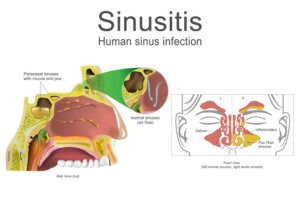Have you ever developed a runny nose, red and puffy eyes, or experienced throbbing headaches that keep coming back? Do your symptoms seem to disappear, only for you to wake up several days to weeks later with a nose so stuffy and congested that you find it hard to rest and breathe? Millions of people like your experience similar symptoms and assume they are suffering from recurring colds or allergy attacks. While those symptoms are common in many upper respiratory conditions, they are also major signs of sinusitis.
Sinusitis is a condition that develops when the sinus cavities become inflamed and often infected. This type of inflammation is usually triggered by colds, allergies or irritants. However, anything that causes inflammation and irritation to the nasal airways and sinus cavities can result in infection and blockage, such as nose injuries (i.e. fractures), cartilage and septum deviations, nasal polyps, fungi, pollen, humidity, etc.
Types of Sinusitis by Occurrence
Before proper treatment can be considered, it’s paramount to know the type of sinusitis you have. A clear way to distinguish allergies, colds, and other viral infections from sinusitis is by the frequency of symptom development and their severity.
Acute sinus infections are the most prevalent type because they stem from colds, bacterial infections, fungi, allergies, etc. Most people with acute sinusitis experience mild to moderate sinus and nasal swelling and congestion. Symptoms also include persistent nasal discharge, headaches, facial pain, bad breath, etc. The average timeframe for acute sinusitis to resolve ranges from a few days to three to four weeks. Acute sinus infections can occur suddenly and redevelop a few times a year. Most people with acute infections manage their discomfort with OTC and personal remedies well as antibiotics and rinses.
Recurrent sinusitis has similar triggers as other types of sinus infections, but the symptoms do not stay away for long. Sinus infections that redevelop at least four times within a 12-month period are recurrent. Recurrent sinusitis often develops when there are underlying health conditions or structural issues in the nasal cavity.
Subacute sinus infections are also a consequence of nasal and sinus inflammation and congestion. Instead of going away within several weeks, subacute infections can linger up to 8-10 weeks. During that time, symptoms may wax and wane or progress, prolonging the pain, discomfort, and misery patients experience. Subacute sinusitis can often become chronic.
Chronic sinusitis is an ongoing inflammation and infection. The symptoms may flare up and persist for several days to months only to become dormant until triggered into an active state. Active chronic sinus infections can last up to eight weeks or longer. Most chronic sinusitis infections are not too responsive to traditional medications, such as antibiotics, sprays, rinses or other home remedies. Surgical intervention combined with medical management are the most effective long-term treatment option for such patients. Also, people with chronic sinusitis may develop nasal polyps and secondary infections.
Keep in mind that it’s not uncommon for colds, allergies, and other viral conditions to develop into acute sinusitis before becoming recurrent, subacute, or chronic. It’s extremely important to have any suspected sinus infections diagnosed for prompt and accurate treatment. Unlike, allergies and colds, sinusitis doesn’t usually respond too well to OTC and home remedies. The symptoms may lessen in severity or temporarily disappear or persist and progress instead of resolving like colds and allergies. Usually, the most effective way to manage sinusitis is with prescription medication, surgery, or a combination of both.
Infections by Sinus Location

In the sinus and nasal cavities, the mucosa produces mucus to keep the passageways in the nose and sinuses from drying out. The mucus has antimicrobial properties that help prevent bacteria, germs, dust, and other airborne irritants from getting into your lungs. When the mucosa or membranes that line the paranasal spaces become inflamed, they produce more mucus and swell. Swelling restricts proper airflow and mucus drainage. Mucus that cannot drain from the mucosa accumulates in the sinus cavities, causing the nasal passages to become narrower and in some cases blocked.
Sphenoid sinusitis is an infection in the sinuses located behind the eyes that cause headaches and eye pain and tenderness. This type of infection is not too common but very dangerous.
Maxillary sinusitis develops when the sinus cavities within the cheekbones become inflamed or infected. Symptoms include facial pain and swelling and headaches.
Frontal sinusitis occurs when sinus cavities in the forehead area become inflamed or irritated. The most common signs are throbbing headaches and facial pressure and pain.
Ethmoid sinusitis occurs when the sinus openings deep inside the nasal cavities between the eyes become irritated or inflamed, causing throat soreness, postnasal drip, taste and smell loss, headaches, and facial pain.
The most common signs of sinusitis development include nasal congestion, swollen and puffy eyes, headaches, poor sleep, snoring, runny nose, and postnasal drip, colored nasal discharge, chronic cough and sore throat. Brain fog, sleep apnea, snoring, and fatigue are also extremely common.
Contact Us for Sinusitis Relief
Sinusitis and sinus infections have similar symptoms making it difficult for sufferers to successfully identify and manage their conditions on their own. Proper diagnosis is necessary. Contact the Southern California Sinus Institute and world-renowned expert, Dr. Alen Cohen, at (818) 888-7878 to learn safe and effective sinusitis treatments that will allow you to resume your social, professional, and personal activities with ease. All treatments are administered by Dr. Alen Cohen, M.D., F.A.C.S., Los Angeles’ very own ENT specialist extraordinaire.

